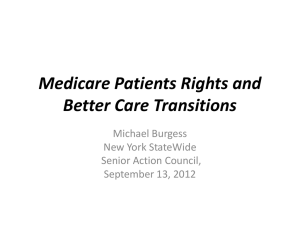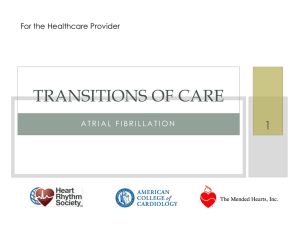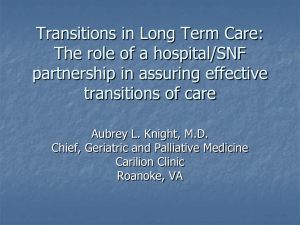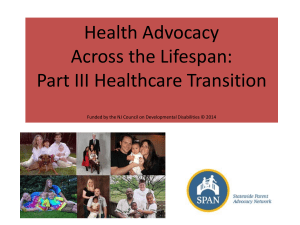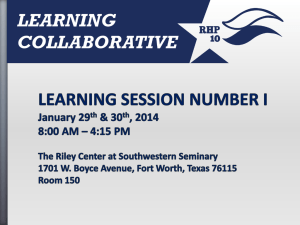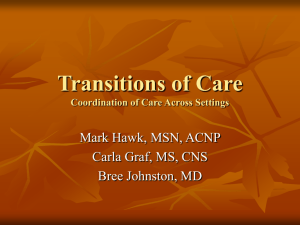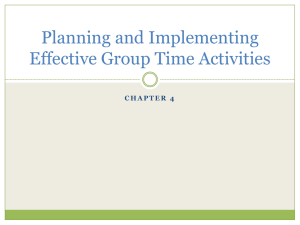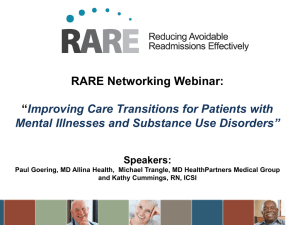An Interactive Case Study: Alzheimer*s Dementia in Long
advertisement
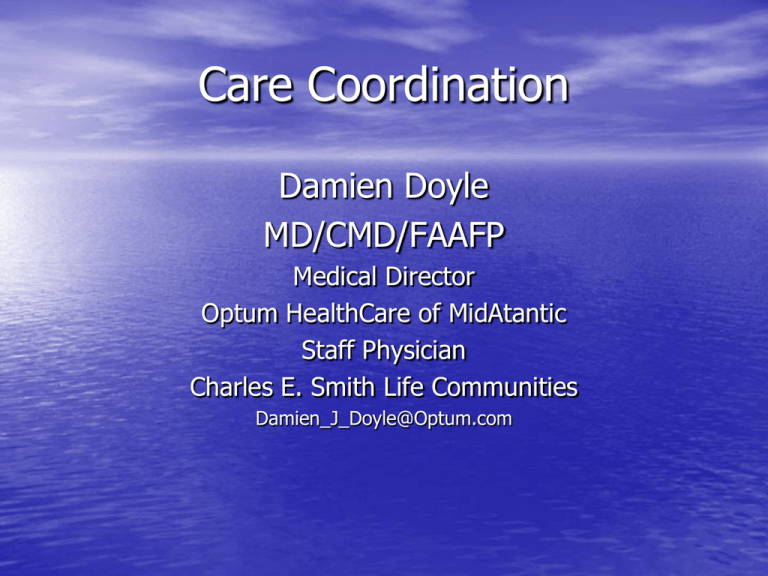
Care Coordination Damien Doyle MD/CMD/FAAFP Medical Director Optum HealthCare of MidAtantic Staff Physician Charles E. Smith Life Communities Damien_J_Doyle@Optum.com “The single biggest problem with communication is the illusion that it has taken place” George Bernard Shaw System vs. Patient – An inherent Conflict • Care delivered by specialized practitioners with narrow focus • Organizations deliver care along product lines and specialties and are site specific • Patients are increasingly complex with a greater variety of co-morbidities managed in a growing variety of settings Too many cooks…. • Typical Medicare beneficiary sees an average of 2 PCPs and 5 specialists annually • Who coordinates this care? Care Coordination Definition • Many definitions exist and this is part of the • confusion “The term ‘care coordination’ has no wellestablished definition. Rather, it is generally understood to mean a process of improving communication among the various medical professionals with whom patients come in contact and between these professionals and the patients themselves (and their families).” Brown 2004 Care Coordination Definition • From the National Library of Medicine, Closing the Quality Gap Vol. 7 “the deliberate organization of patient care activities between two or more participants (including the patient) involved in a patient's care to facilitate the appropriate delivery of health care services.” Care Coordination Goals • (1) identify the full range of medical, functional, social, • • • and emotional problems that increase patients' risk of adverse health events (2) address those needs through education in self-care, optimization of medical treatment, and integration of care fragmented by setting or provider (3) monitor patients for progress and early signs of problems Such programs hold the promise of raising the quality of health care, improving health outcomes, and reducing the need for costly hospitalizations and medical care.” • Chen 2000 Transition of Care Definition • Movement of patients between health care locations, providers or different levels as their care needs change – Within settings • PCP to specialist • ICU -> ward – Between settings • Hospital -> Subacute or Home – Across health states • Curative -> Palliative AMDA Transitions of Care Practice Guideline 2010 Care Transitions: Definition • “Care Transitions” refers to the movement patients make between health care practitioners and settings as their conditions and care needs change during the course of a chronic or acute illness 9 Care Coordination and Transition of Care are critically and inherently linked Charles E. Smith Life Communities OUR SPECTRUM OF SERVICES Most Acute Subacute Subacute Medical Model Nursing Home Outpatient Diagnostic & Treatment Least Acute Least Restrictive Social Model Hebrew Home Home Living Support Independent Living Assisted Living Hebrew Home 451 Beds 1969 Wasserman Smith -Kogod 1981 Landow House 2005 60 Units Hirsh Health Center 1991 Home Care Solutions, LLC Joint Ownership Augustine Home Health Ring 1989 Revitz 1978 70 Bed Unit ( 250 Apts.) (250 Apts.) 2000 37 Total Acres21 CARE MANAGEMENT Most Restrictive Is This Really a Problem? • ~ 10% of all NH residents had an ED visit in • past 90 days Of these, 40% have a potentially preventable cause (Caffrey, US Dept HHS 2004) • Of Patients who are hospitalized, – 19% re-hospitalized within 30 days – 42% re-hospitalized within 24 months • Hard to define what is the appropriate/expected number What illustrates bad Care Coordination • • • • • • • Medication Errors Increased Health Care Utilization Inefficient/Duplicative Care Inadequate patient/caregiver preparation Inadequate follow-up care Dissatisfaction Litigation/Bad publicity • • Eric Coleman, MD/MPH University of Colorado, Denver High Risk for Transition Problems • • • • • • • • • Multiple Medical Problems Dementia Depression or other Mental Health issues Isolated – lack of caregivers Poverty Non-English speaking Minorities Recent immigrants and refugees IE, most of our patients! What are the Common Factors? • Most transitions are unplanned and due to acute illness • Patients are vulnerable – functional loss, delirium, pain and anxiety are all common • Only true common factor is the patient themselves What Can We Do? • Move? • Give up? Safer Coordination • Communication • Medication Reconciliation • Patient Centered Care • End of Life Care – Patient driven plan of care Safer Coordination Communication • Discharge Instructions – Expectations – Shift the concept of “discharge” to “transfer with continuous management” – Begin transfer planning upon admission – Incorporate patient/caregiver preferences – Identify social support and function – Collaborate with practitioners across the spectrum Safer Coordination – Communication • Expectations for the Transferring Team – Patient is Stable – Patient and caregiver understand the purpose of the transfer – Patient and caregiver understand their coverage – Receiving institution is capable and prepared – Care plan, orders, and clinical summary precede the patient’s arrival – Timely follow-up is arranged Safer Coordination – Communication • Expectations for the Receiving Team – Review the transfer forms, clinical summary and orders – Incorporate the patient/caregiver goals and preferences – Clarify any discrepancies regarding the care plan, patient’s status or medications Care Coordination Models • Key national models – Care Transitions Program – Transitional Care Model – Transforming the Care at the Bedside – Project RED (Re-Engineer Discharge) – Project Better Outcomes for Older adults through Safe Transitions (BOOST) 23 Care Transitions: Four Pillars Coleman, Univ. of Colorado www.caretransitions.org Celtic Healthcare 24 Transitional Care Model Naylor, Univ. of Pennsylvania Celtic Healthcare 25 Transforming The Care at the Bedside Model Institute of Healthcare Improvement Celtic Healthcare 26 Project RED Boston University Celtic Healthcare 27 Home Healthcare Role • Transition Coach” (Nurse or MSW) – Prepares patient for what to expect and to speak up – Educated on use of a Personal Health Record – Educates the care team in home of patient’s needs • Follows patient to the home – Reconcile pre- and post-hospital medications – Practice or “role-play” next encounter or visit • Phone calls after discharge – Single point of contact; reinforce, ensure follow up • Does not replace hospital discharge planning! Celtic Healthcare Specialized Care Models • ISNP (Institutional Special Needs Population) – Medicare Advantage Programs • Home Care Management Programs • NORC (Naturally Occurring Retirement Communities) http://www.aoa.gov/AoARoot/AoA_Programs/OAA/oaa_full.asp#_Toc15395 7728 Resources and References • Home Health Quality Improvement Campaign – Original Campaign Transitional Care Coordination Best Practice Package and resources • www.homehealthquality.org/hh/ed_resources/intervention packages/tcc.aspx – Current Campaign • www.homehealthquality.org – Care Transitions Program • www.caretransitions.org • Coleman, E., et. Al. (2006). ARCH INTERN MED., Vol. 166. 30 Care Transition Tools and Resources (cont.) • Medication Management Tools • • 31 – Collaboration for Homecare Advances in Management and Practice (CHAMP) Program – www.champ-program.org Barriers to Medication Adherence, Medication Management Evidence Brief, Reducing Adverse Drug Events Beers Criteria, ARMOR Polypharmacy Tool, How to Write a Pill Card, Medication Reconciliation Process, Risk Assessment for Non-adherence, Script for Adherence Counseling, Speak Up Brochure – Help Avoid Mistakes with Your Medicines, Tips for Preventing Problems When Taking Multiple Medications, Your Medications – What to ask • “There was an important job to be done and Everybody was sure that Somebody would do it. Anybody could have done it, but Nobody did it… Everybody blamed Somebody when Nobody did what Anybody could have done” – Anonymous
